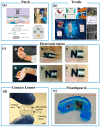Flexible and Wearable Biosensors for Monitoring Health Conditions
- PMID: 37366995
- PMCID: PMC10296135
- DOI: 10.3390/bios13060630
Flexible and Wearable Biosensors for Monitoring Health Conditions
Abstract
Flexible and wearable biosensors have received tremendous attention over the past decade owing to their great potential applications in the field of health and medicine. Wearable biosensors serve as an ideal platform for real-time and continuous health monitoring, which exhibit unique properties such as self-powered, lightweight, low cost, high flexibility, detection convenience, and great conformability. This review introduces the recent research progress in wearable biosensors. First of all, the biological fluids often detected by wearable biosensors are proposed. Then, the existing micro-nanofabrication technologies and basic characteristics of wearable biosensors are summarized. Then, their application manners and information processing are also highlighted in the paper. Massive cutting-edge research examples are introduced such as wearable physiological pressure sensors, wearable sweat sensors, and wearable self-powered biosensors. As a significant content, the detection mechanism of these sensors was detailed with examples to help readers understand this area. Finally, the current challenges and future perspectives are proposed to push this research area forward and expand practical applications in the future.
Keywords: E-skins; self-powered biosensors; sweat sensors; wearable sensors.
Conflict of interest statement
The authors declare no conflict of interest.
Figures








References
-
- Chen X., Luo F., Yuan M., Xie D., Shen L., Zheng K., Wang Z., Li X., Tao L. A Dual-Functional Graphene-Based Self-Alarm Health-Monitoring E-Skin. Adv. Funct. Mater. 2019;29:1904706. doi: 10.1002/adfm.201904706. - DOI
Publication types
MeSH terms
Grants and funding
LinkOut - more resources
Full Text Sources
Research Materials
Miscellaneous

